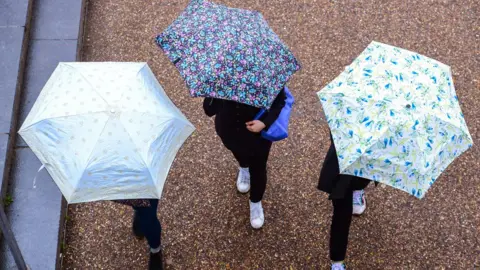Indoor dining boost drowned out by record May rain
 PA Media
PA MediaThe reopening of indoor bars and restaurants last month failed to boost footfall on UK High Streets and shopping centres following May's record rainfall, according to new data.
Analysis by Springboard shows footfall was 27.5% lower compared to pre-pandemic May 2019.
The hospitality industry in England reopened indoors on 17 May.
But while footfall improved from April, activity was "muted" due to the weather and a limit on dining numbers.
At present, only groups of up to six people or a larger gathering of two households are allowed inside hospitality venues. And those serving alcohol must provide table service only.
Springboard said the gap between in footfall compared to May 2019 actually widened as the month wore on, from a fall of 25.3% in the first week to a drop of 26.8% in the final week.
"There are several reasons for this," said Springboard's insights director Diane Wehrle. "Firstly, May was the wettest on record which inevitably lowered the initial exhilaration of consumers in being able to eat out as even visiting indoor environments necessitated braving the weather.
"Secondly, the limitations on dining capacity in indoor venues inevitably means that the uplift in footfall generated has been limited."
High Streets showed the biggest drop with footfall down 36,3% compared with pre-pandemic May, followed by shopping centres with 30.3% fewer visitors. Retail parks recorded a lower decline in footfall of 5.7%.
Springboard said there is evidence that consumers are "drifting back into larger destinations for work or leisure" with footfall between April and May higher in central London and other regional cities.
But it said it was not yet clear whether this uptick of activity in UK cities would continue.
"This will be strongly dependent on whether the government's roadmap for the easing of restrictions will proceed as planned or whether easing will be deferred beyond 21 June," said Ms Wehrle.
